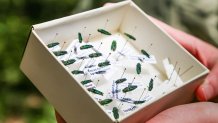After confirming the presence of the emerald ash borer within city limits last week, the city's parks department is working with the Texas A&M Forest Service and other city departments to monitor the spread of the invasive beetle.
The non-native small green beetle is devastating to ash tree populations, boring its way into the bark of the tree where it lays eggs. The beetle's larvae eventually feed on the tree's water-conducting tissue, slowly killing the tree.
Last week the city confirmed the beetle had been located near the intersection of Texas Loop 12 and Interstate 30 and in the Great Trinity Forest, which is estimated to be made up of 40% ash trees. City officials are also working to confirm reports of EAB activity in North Dallas along White Rock Creek.
To track the spread of this destructive insect, the city said park officials placed traps to catch the beetles throughout affected areas within the city. The Dallas Parks Department will report its findings to the Texas Forest Service.
Get top local stories in DFW delivered to you every morning. Sign up for NBC DFW's News Headlines newsletter.
Along with monitoring the beetle’s spread, the park department will treat select ash trees in city parks to protect against infestation. They'll also do physical evaluations of infected and declining ash trees.
"We want to make sure we are looking out for potential threats created by the emerald ash borer. Trees are one of nature’s most precious assets and we have to preserve them for us now and for future generations,” said Christopher McMaster, a certified arborist and the department’s urban forestry manager.
In June, Dallas Park and Recreation and national tree care specialist Arborjet will host a tree health and EAB workshop for interested residents, arborists, and companies who manage EAB and other pests and diseases threatening Texas trees. Residents can find resources to protect their ash trees at the City of Dallas Emerald Ash Borer information page.
Local
The latest news from around North Texas.
WHAT IS AN EMERALD ASH BORER?
The emerald ash borer is a small beetle, green in color and smaller than a penny.
The beetle bores its way into the tree's bark and lays eggs. Larvae feed on water-conducting tissue, eventually killing the tree.
Officials said the insect has been confirmed in more than half of the United States and has killed millions of ash trees.
"Both healthy and unhealthy ash trees are susceptible to an EAB attack and may die within two or three years after becoming infested," said Allen Smith, Texas A&M Forest Service regional forest health coordinator, during an interview with NBC 5 in May 2022. "Ash trees have no natural resistance to the exotic insect. Without proper proactive measures, mortality can be 100% in heavily infested areas, so early detection could improve our chances to manage the pest."
Ash trees with low numbers of EAB often have few or no external symptoms of infestations. However, residents can look for signs of EAB among their ash trees, including dead branches near the top of the tree, leafy shoots sprouting from the trunk, bark splits exposing s-shaped larval galleries, extensive woodpecker activities, and D-shaped exit holes.
The beetle was first discovered in North America in 2002 in Michigan. It has since spread to at least 36 states, killing millions of ash trees.
To report emerald ash borer, please call the EAB Hotline at 1-866-322-4512.




